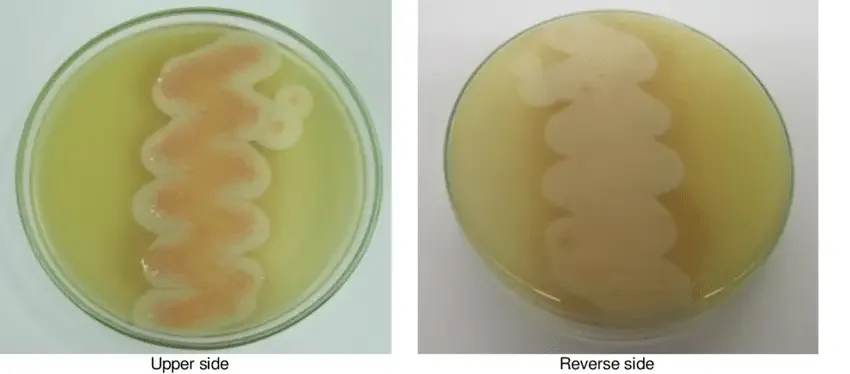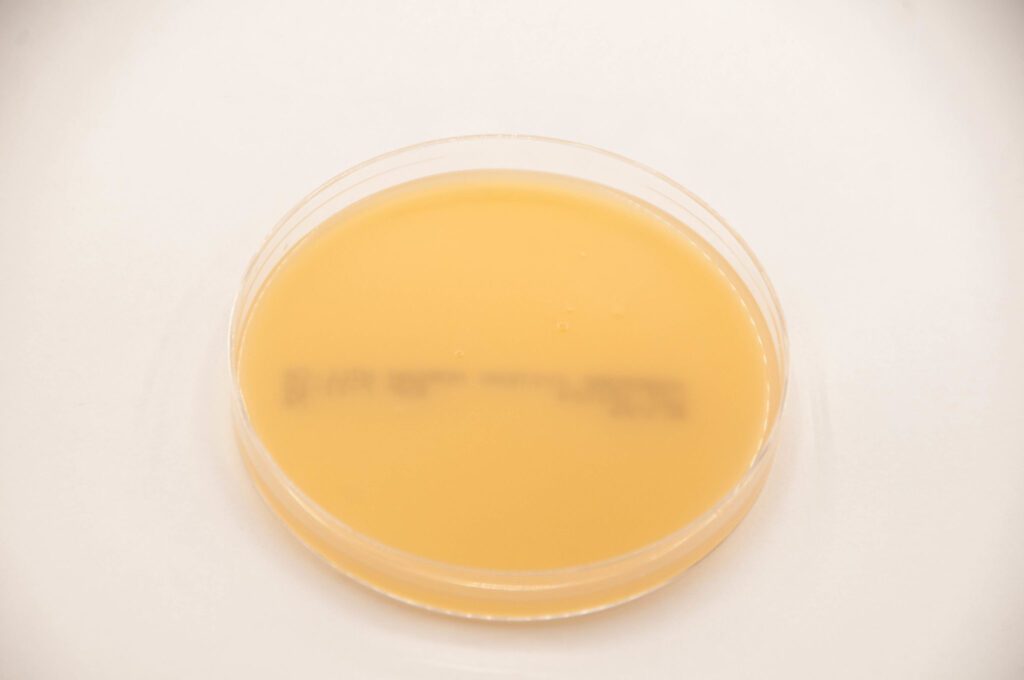Introduction
Egg Yolk Agar is a specialized microbiological medium used widely in clinical and research laboratories to detect specific enzymatic activities, particularly those related to lipase and lecithinase production. It is especially valuable for identifying Clostridium species, Staphylococcus aureus, and other microorganisms capable of breaking down egg yolk components.

What makes this medium unique is the presence of egg yolk emulsion, which provides lecithin, lipids, and other nutrients that microorganisms can metabolize. Their enzymatic activity leads to distinct visual changes on the agar, which helps in diagnosis and microbial characterization. This document provides an in-depth yet simple and humanized explanation of Egg Yolk Agar, including its composition, principle, preparation steps, interpretation of results, and its various uses.
Table of Contents
What is Egg Yolk Agar?
Egg Yolk Agar is an enriched, non-selective, differential medium used primarily to detect the lipolytic (lipase) and lecithinase activity of bacteria. The medium contains egg yolk emulsion, which serves as a substrate for these enzymes.

When certain bacteria grow on this medium, they produce enzymes that break down lecithin and triglycerides present in the egg yolk. This breakdown leads to specific visual reactions such as precipitation, iridescent sheen, or clear zones, depending on the enzyme produced.
Composition of Egg Yolk Agar
The basic formulation of Egg Yolk Agar includes:
Base Medium (per liter of distilled water):
- Trypticase peptone: 15.0 g
- Yeast extract: 5.0 g
- Sodium chloride (NaCl): 5.0 g
- Agar: 15.0 g
- Distilled water: 1000 ml
Supplement:
- Egg yolk emulsion (Sterile): 100 ml (10% v/v)
Note: Commercial media are available, but labs may prepare it manually using freshly prepared or commercially available sterile egg yolk emulsion.
Optional additives (for selective versions):
- Antibiotics: Can be added to inhibit the growth of competing organisms
- Cysteine or Vitamin K: For anaerobic growth (e.g., in Clostridium species)
Principle of Egg Yolk Agar
The diagnostic value of Egg Yolk Agar lies in detecting two main enzyme activities:
1. Lecithinase Activity
- Lecithinase (phospholipase C) hydrolyzes lecithin, a phospholipid found in egg yolk, into diglycerides, phosphorylcholine, and other byproducts.
- This reaction causes an opaque white precipitate to form around colonies.
- It is especially significant in identifying Clostridium perfringens.
2. Lipase Activity
- Lipase hydrolyzes triglycerides in egg yolk into glycerol and free fatty acids.
- This leads to the appearance of an iridescent sheen or oil-on-water appearance around colonies.
- Seen in organisms like Staphylococcus aureus and Clostridium sporogenes.
Preparation of Egg Yolk Agar

Materials Required:
- Trypticase peptone
- Yeast extract
- Sodium chloride
- Agar powder
- Distilled water
- Sterile egg yolk emulsion (or freshly prepared from sterile eggs)
- Sterilization equipment (autoclave, sterile bottles, Petri dishes)
Step-by-Step Procedure:
1. Prepare the Basal Medium:
- Weigh the dry ingredients:
- Trypticase peptone: 15 g
- Yeast extract: 5 g
- NaCl: 5 g
- Agar: 15 g
- Add to 900 ml of distilled water.
- Mix well and heat gently to dissolve all components.
2. Sterilize the Base:
- Autoclave the solution at 121°C for 15 minutes.
- Allow to cool to about 50–55°C.
3. Add Sterile Egg Yolk Emulsion:
- Add 100 ml of sterile egg yolk emulsion aseptically to the cooled base.
- Mix gently without creating bubbles.
4. Dispense the Medium:
- Pour into sterile Petri dishes (~20 ml per plate).
- Allow to solidify at room temperature.
5. Storage:
- Store the prepared plates in a refrigerator (2–8°C).
- Use within 1–2 weeks to ensure activity of egg yolk components.
Inoculation and Incubation
Sample Types:
- Clinical specimens (pus, tissue, wound swabs)
- Food samples (for detecting foodborne pathogens)
- Soil samples (especially for Clostridium)
Procedure:
- Streak the bacterial isolate on the surface of the Egg Yolk Agar.
- For anaerobes, place the plate in an anaerobic jar.
- Incubate:
- Aerobic organisms: 24–48 hours at 35°C
- Anaerobic organisms: 48 hours at 35°C under anaerobic conditions
Interpretation of Results
Positive Reactions:
1. Lecithinase Positive
- Opaque white precipitate around colonies
- Seen in:
- Clostridium perfringens
- Bacillus cereus
- Staphylococcus aureus
2. Lipase Positive
- Iridescent sheen, oil-on-water appearance
- Seen in:
- Staphylococcus aureus
- Clostridium sporogenes
- Pseudomonas aeruginosa (less commonly)
Negative Reactions:
No precipitate or sheen around the colonies
Mixed Reactions:
- Some bacteria may produce both lecithinase and lipase activities
- Both reactions can be seen simultaneously
Uses of Egg Yolk Agar
Egg Yolk Agar has multiple applications in clinical, food, and environmental microbiology:
1. Identification of Clostridium Species
- Clostridium perfringens: Strong lecithinase activity
- Clostridium sporogenes: Lipase-positive
- Helps distinguish between different Clostridium species
2. Identification of Staphylococcus aureus
- Shows both lecithinase and lipase activity
- Helps differentiate from coagulase-negative staphylococci
3. Detection of Bacillus cereus
- Produces a wide zone of lecithinase activity
- Useful in foodborne illness investigations
4. Differentiation of Anaerobic Bacteria
- Some anaerobes show strong enzymatic activity on egg yolk agar
- Helpful in anaerobic culture labs
5. Research and Teaching
- Demonstrates enzymatic reactions in microbiology education
- Useful in studying virulence factors
6. Food and Water Microbiology
- Helps detect lipolytic and lecithinolytic spoilage organisms
- Important in dairy and meat product testing
Advantages of Egg Yolk Agar
- Simple and cost-effective
- Easy visual interpretation
- Supports both aerobic and anaerobic bacteria
- Can be used for a wide variety of sample types
- Useful in differentiating similar organisms
Limitations of Egg Yolk Agar
- Not highly selective; overgrowth of non-target organisms can occur
- Results can be influenced by incubation conditions
- Requires anaerobic setup for certain organisms
- Visual interpretation may be subjective
Safety Precautions
- Always use aseptic technique
- Handle pathogenic organisms in biosafety level-appropriate environments
- Dispose of plates and materials properly
Conclusion
Egg Yolk Agar is a versatile and important differential medium in microbiology, designed to detect lecithinase and lipase enzyme activity in bacteria. The unique incorporation of egg yolk provides the necessary substrates to observe these enzymatic effects directly on the agar surface. This makes it a valuable tool for the identification of clinically significant bacteria like Clostridium perfringens, Staphylococcus aureus, and Bacillus cereus.
Its wide application in clinical, food, and environmental microbiology demonstrates its relevance and reliability. Although interpretation requires experience and careful handling, the simplicity and effectiveness of Egg Yolk Agar continue to make it a popular choice in diagnostic laboratories.
Three Key Summary
- Egg Yolk Agar detects lecithinase and lipase enzyme activity, helping identify various bacterial pathogens.
- It is useful for differentiating organisms like Clostridium, Staphylococcus aureus, and Bacillus cereus.
- The medium is simple to prepare, interpret, and widely applicable in medical, food, and research microbiology.
FREQUENTLY ASKED QUESTIONS
What does a positive lecithinase test look like on Egg Yolk Agar?
A positive test appears as a white, opaque halo or precipitate around the bacterial colony.
Can Egg Yolk Agar detect both aerobic and anaerobic organisms?
Yes. The medium supports both types, but anaerobic organisms must be incubated under anaerobic conditions.
Why is egg yolk used in the medium?
Egg yolk provides lecithin and lipids, which serve as substrates for detecting lecithinase and lipase activity.
Related Articles




